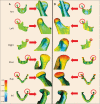Three-dimensional cone beam computed tomography analysis of temporomandibular joint response to the Twin-block functional appliance
- PMID: 32257934
- PMCID: PMC7093662
- DOI: 10.4041/kjod.2020.50.2.86
Three-dimensional cone beam computed tomography analysis of temporomandibular joint response to the Twin-block functional appliance
Abstract
Objective: To propose a three-dimensional (3D) method for evaluating temporomandibular joint (TMJ) changes during Twin-block treatment.
Methods: Seventeen patients with Class II division 1 malocclusion treated using Twin-block and nine untreated patients with a similar malocclusion were included in this research. We collected their cone beam computed tomography (CBCT) data from before and 8 months after treatment. Segmentations were constructed using ITK-SNAP. Condylar volume and superficial area were measured using 3D Slicer. The 3D landmarks were identified on CBCT images by using Dolphin software to assess the condylar positional relationship. 3D models of the mandible and glenoid fossa of the patients were constructed and registered via voxel-based superimposition using 3D Slicer. Thereafter, skeletal changes could be visualized using 3DMeshMetric in any direction of the superimposition on a color-coded map. All the superimpositions were measured using the same scale on the distance color-coded map, in which red color represents overgrowth and blue color represents resorption.
Results: Significant differences were observed in condylar volume, superficial area, and condylar position in both groups after 8 months. Compared with the control group (CG), the Twin-block group exhibited more obvious condyle-fossa modifications and joint positional changes. Moreover, on the color-coded map, more obvious condyle-fossa modifications could be observed in the posterior and superior directions in the Twin-block group than in the CG.
Conclusions: We successfully established a 3D method for measuring and evaluating TMJ changes caused by Twin-block treatment. The treatment produced a larger condylar size and caused condylar positional changes.
Keywords: Computed tomography; Functional; Temporomandibular joint; Three-dimensional cephalometrics.
© 2020 The Korean Association of Orthodontists.
Conflict of interest statement
CONFLICTS OF INTEREST: No potential conflict of interest relevant to this article was reported.
Figures








Similar articles
-
Three-dimensional spatial analysis of temporomandibular joint in adolescent Class II division 1 malocclusion patients: comparison of Twin-Block and clear functional aligner.Head Face Med. 2024 Jan 6;20(1):4. doi: 10.1186/s13005-023-00404-y. Head Face Med. 2024. PMID: 38184631 Free PMC article.
-
[Cone-beam CT evaluation of the changes in the temporomandibular joint of patients with class II division 1 subdivision malocclusion before and after twin-block treatment].Hua Xi Kou Qiang Yi Xue Za Zhi. 2013 Dec;31(6):610-4. Hua Xi Kou Qiang Yi Xue Za Zhi. 2013. PMID: 24437298 Chinese.
-
Three-dimensional analysis of mandibular and condylar growth using artificial intelligence tools: a comparison of twin-block and Frankel II Appliances.BMC Oral Health. 2025 Feb 18;25(1):254. doi: 10.1186/s12903-025-05624-z. BMC Oral Health. 2025. PMID: 39966790 Free PMC article.
-
Comparison of Skeletal Changes in the Temporomandibular Joint between the Twin Block Appliance and Fixed Functional Appliance: A Longitudinal Follow-up Study.Int J Clin Pediatr Dent. 2024 Jan;17(1):7-14. doi: 10.5005/jp-journals-10005-2727. Int J Clin Pediatr Dent. 2024. PMID: 38559857 Free PMC article.
-
Three-dimensional skeletal, dentoalveolar and temporomandibular joint changes produced by Twin Block functional appliance.J Orofac Orthop. 2018 Jul;79(4):245-258. doi: 10.1007/s00056-018-0137-1. Epub 2018 Apr 16. J Orofac Orthop. 2018. PMID: 29663034 English.
Cited by
-
Comparison of surface- and voxel-based registration on the mandibular ramus for long-term three-dimensional assessment of condylar remodelling following orthognathic surgery.Dentomaxillofac Radiol. 2022 May 1;51(4):20210499. doi: 10.1259/dmfr.20210499. Epub 2022 Feb 25. Dentomaxillofac Radiol. 2022. PMID: 35143288 Free PMC article.
-
Treatment of severe open bite and mandibular condyle anterior displacement by mini-screws and four second molars extraction: A case report.World J Clin Cases. 2023 May 26;11(15):3599-3611. doi: 10.12998/wjcc.v11.i15.3599. World J Clin Cases. 2023. PMID: 37383903 Free PMC article.
-
A long-term longitudinal study of the osteoarthritic changes to the temporomandibular joint evaluated using a novel three-dimensional superimposition method.Sci Rep. 2021 Apr 30;11(1):9389. doi: 10.1038/s41598-021-88940-y. Sci Rep. 2021. PMID: 33931699 Free PMC article.
-
A Three-Dimensional Evaluation of Skeletal and Dentoalveolar Changes in Growing Class II Patients after Functional Appliance Therapy: A Retrospective Case-Control Study.J Clin Med. 2024 Feb 26;13(5):1315. doi: 10.3390/jcm13051315. J Clin Med. 2024. PMID: 38592176 Free PMC article.
-
Recommendations for standard criteria for the positional and morphological evaluation of temporomandibular joint osseous structures using cone-beam CT: a systematic review.Eur Radiol. 2024 May;34(5):3126-3140. doi: 10.1007/s00330-023-10248-4. Epub 2023 Oct 25. Eur Radiol. 2024. PMID: 37878020 Free PMC article.
References
-
- Baccetti T, Franchi L, Toth LR, McNamara JA., Jr Treatment timing for Twin-block therapy. Am J Orthod Dentofacial Orthop. 2000;118:159–170. - PubMed
-
- Jena AK, Duggal R, Parkash H. Skeletal and dentoalveolar effects of Twin-block and bionator appliances in the treatment of Class II malocclusion: a comparative study. Am J Orthod Dentofacial Orthop. 2006;130:594–602. - PubMed
-
- Lund DI, Sandler PJ. The effects of Twin Blocks: a prospective controlled study. Am J Orthod Dentofacial Orthop. 1998;113:104–110. - PubMed
-
- Morris DO, Illing HM, Lee RT. A prospective evaluation of Bass, Bionator and Twin Block appliances. Part II--The soft tissues. Eur J Orthod. 1998;20:663–664. - PubMed
-
- Trenouth MJ. Cephalometric evaluation of the Twin-block appliance in the treatment of Class II Division 1 malocclusion with matched normative growth data. Am J Orthod Dentofacial Orthop. 2000;117:54–59. - PubMed
LinkOut - more resources
Full Text Sources
